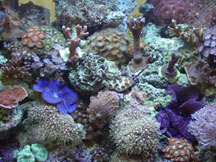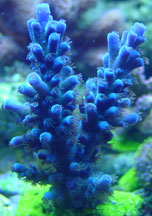| Michael Paletta - Guest Author |

|
As calcium supplementation has gotten more automated, one of the more sophisticated means of achieving and maintaining desired calcium levels is through the use of a calcium reactor. When used properly, this method provides a very precise means of maintaining calcium levels within a system. Other than some adjustments, calcium reactors offer very few problems.
|
|
These reactors, such as the
CA+ Calcium Reactor, produce a calcium solution by dissolving a calcareous media (e.g.,
Aragonite Reactor Media) in low pH water. The low pH is achieved by introducing
carbon dioxide into the reaction chamber. The rate of calcium supplementation is determined by the flow rate through the reactor chamber and the amount of the carbon dioxide dissolving the calcareous media.
Advantages
- Automated calcium supplementation - When set up properly and used correctly, a calcium reactor can maintain or increase calcium levels with little maintenance.
- Great for large reef setups with high calcium demands.
- Low long-term maintenance cost - After purchasing and setting up a unit, the only items that need to be replenished are carbon dioxide and calcareous media.
- Straightforward set up and maintenance.
|
 |
|
Caveat - Calcium reactors, however, are not without some drawbacks.
- High initial set up cost - These units are relatively expensive and in addition to the reactor itself, a proper setup will also require a
carbon dioxide tank, CO2 regulator, needle valve and a pH controller.
- Flow rate and carbon dioxide levels need to be manually set and adjusted at appropriate levels to facilitate proper calcium supplementation.
As long as certain precautions are taken and conditions are properly maintained, there is little problem in running a calcium reactor. Before turning on the reactor, the calcium and alkalinity levels should be tested and noted so that a baseline or reference point has been established. These levels will then be used to determine if the reactor is working at an optimum level.
As with any type of calcium supplementation, levels for calcium and alkalinity should be tested and monitored closely to make sure everything is working properly. To get the most out of your calcium reactor, the following aspects should be considered; proper
media, size, flow rate, carbon dioxide level,
pH level, regular
testing, and long-term maintenance. |
 |
- Media Selection - Some media may contain a lot of phosphate resulting in the release of phosphate as the media dissolves. Fortunately phosphate-free media, such as
Aragonite Reactor Media, is now available.
- Proper Size - Make sure the unit is appropriately sized especially for large reef systems with large quantities of SPS corals and coralline algae. An undersized unit may do a good job initially but over time, the reactor can no longer produce enough dissolved calcium to meet the calcium demands. It is now possible to find a calcium reactor for even the largest of aquariums.
- Flow Rate - Flow rate should be set at 1-2 liters per hour, depending on the aquarium size, through the reactor. The flow rate can be increased or decreased to adjust calcium levels in your aquarium. If the flow rate through the chamber needs to be increased, then the CO2 bubble rate will also need to be increased. Keep in mind that the flow rate may need to be increased frequently in reef aquariums containing large quantities of SPS corals as the corals utilize more and more calcium.
- Carbon dioxide level - The amount of CO2 should initially be set at 1-2 bubbles per second. Carbon dioxide levels need to be closely monitored so that excess CO2 is not introduced into the aquarium. Avoid excess CO2 in two ways: by using a properly functioning needle valve and
bubble counter in combination with a
pH controller, and by adding CO2 to a lightly aerated area in the aquarium.
- PH level - The effluent from the reactor should be checked so that it reads a pH of approximately 6.5. For calcareous media to dissolve efficiently, the pH will need to be around 6.5. If the pH is higher, increase the amount of CO2 or reduce the water flow. It is usually better to adjust the CO2 level, since reducing the water flow will mean less calcium and carbonates flowing into the aquarium.
-
Testing - Calcium and alkalinity levels should be measured and the results should be at least equal to the initial levels (baseline/reference point) or they should be slightly higher. If they are lower, the flow and the CO2 bubble rate will need to be increased.
- Long-term maintenance - Over time, a reduction in flow rate may occur due to buildup so the reactor, pipes, and valves will need to be cleaned periodically. Also, media other than Korallith may turn into a type of inert sludge in the reactor and reduce the amount of calcium being released even though the flow and CO2 levels look normal. The media should be removed and thrown out once or twice per year and the entire reactor should be cleaned out with mild vinegar and thoroughly rinsed. This will help keep the reactor working at an optimum level.
One of the latest advances is to use both a
calcium reactor and a
kalkwasser on aquariums that utilize large amounts of calcium. This combination maintains both calcium and alkalinity levels better than using just a calcium reactor with the added benefit of phosphate reduction and stable pH levels. It may be the optimum way of maintaining calcium levels in a large SPS tank.
Due to better understanding and the continuing development of calcium supplementation methods, SPS corals are now commonplace and their growth rates in some aquariums can exceed the rates seen in the wild. Understanding and implementing proper calcium and alkalinity supplementation may seem difficult at first, but with proper testing and patience, keeping these compounds at their proper levels will become quite simple.
|
Part 6 of 6. Continue reading: |
|
|
Biography
Michael Paletta is the author of two books, "The New Marine Aquarium" and "Ultimate Marine Aquariums," and has acted as a consultant with the National Aquarium in Baltimore and the Pittsburgh Zoo Aquarium. | |